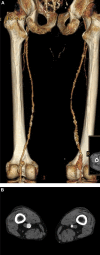Endovascular treatment of aneurysms of the popliteal artery by a covered endoprosthesis
- PMID: 25574145
- PMCID: PMC4274050
- DOI: 10.4137/CMC.S15232
Endovascular treatment of aneurysms of the popliteal artery by a covered endoprosthesis
Abstract
Purpose: The current gold standard of popliteal artery aneurysm (PAA) treatment is saphenous vein bypass grafting. The aim of this retrospective single-center study is to investigate the safety and efficacy in the treatment of PAA by an endovascular implanted covered endoprosthesis.
Materials and methods: Ten patients, mean age 64.6 (range, 52-78) years, with PAA were treated with an expanded Polytetrafluoroethylen (ePTFE)-covered stent graft (Viabahn(®), W.L. Gore and Associates Inc, Flagstaff, AZ, USA). In median, 1.4 prostheses were implanted with a median length of 180 mm. Follow-up visits included determination of ankle-brachial index (ABI) and color-coded duplex sonography.
Results: The technical success rate was 100% (10/10). Clinically, there was an increase in ABI from 0.62 ± 0.17 to 0.91 ± 0.15 postinterventionally and to 0.89 ± 0.16 after an average follow-up of 24.7 months. During the follow-up period, 2 (20%) stent occlusions occurred; both of them were treated with a bypass graft.
Conclusion: The treatment of PAA with covered endoprosthesis is a safe and effective alternative to open surgical therapy, where open surgical therapy is contraindicated or patient refused open surgery.
Keywords: aneurysm; endoprosthesis; popliteal artery.
Figures




Similar articles
-
Long-term results of ePTFE stent-graft versus angioplasty in the femoropopliteal artery: single center experience from a prospective, randomized trial.J Vasc Interv Radiol. 2003 Mar;14(3):303-11. doi: 10.1097/01.rvi.0000058425.01661.d0. J Vasc Interv Radiol. 2003. PMID: 12631634 Clinical Trial.
-
Ten years' experience in endovascular repair of popliteal artery aneurysm using the Viabahn endoprosthesis: a report from two Italian vascular centers.Ann Vasc Surg. 2015 Jul;29(5):941-9. doi: 10.1016/j.avsg.2015.01.008. Epub 2015 Mar 7. Ann Vasc Surg. 2015. PMID: 25757986
-
Outcome of endovascular repair of popliteal artery aneurysm using the Viabahn endoprosthesis.J Vasc Surg. 2012 Jun;55(6):1647-53. doi: 10.1016/j.jvs.2011.12.059. J Vasc Surg. 2012. PMID: 22608040
-
Current status of Hemobahn/Viabahn endografts for treatment of popliteal aneurysms.J Cardiovasc Surg (Torino). 2013 Dec;54(6):785-91. J Cardiovasc Surg (Torino). 2013. PMID: 24126514 Review.
-
Splenic Artery Aneurysm Treated With Endovascular Stent Grafting: A Case Report and Review of Literature.Vasc Endovascular Surg. 2018 Nov;52(8):663-668. doi: 10.1177/1538574418785252. Epub 2018 Jun 25. Vasc Endovascular Surg. 2018. PMID: 29940816 Review.
Cited by
-
Unusual source of fever: the curious case of an infected arterial stent graft presenting as a ruptured popliteal artery aneurysm.BMJ Case Rep. 2021 Feb 23;14(2):e239272. doi: 10.1136/bcr-2020-239272. BMJ Case Rep. 2021. PMID: 33622748 Free PMC article.
-
Treatment of bilateral popliteal artery aneurysms.J Vasc Bras. 2019 Nov 29;19:e20180142. doi: 10.1590/1677-5449.180142. J Vasc Bras. 2019. PMID: 31839798 Free PMC article.
-
Popliteal artery aneurysms treatments: early midterm results of the use of endovascular stent grafts.Turk J Med Sci. 2021 Jun 28;51(3):1106-1114. doi: 10.3906/sag-2005-263. Turk J Med Sci. 2021. PMID: 33356034 Free PMC article.
-
Successful Surgical Treatment of a Ruptured Popliteal Artery Aneurysm With Distal Embolism.Cureus. 2024 Dec 9;16(12):e75365. doi: 10.7759/cureus.75365. eCollection 2024 Dec. Cureus. 2024. PMID: 39781120 Free PMC article.
-
Endovascular Repair of a Traumatic Popliteal Artery Injury.Cureus. 2022 Nov 4;14(11):e31100. doi: 10.7759/cureus.31100. eCollection 2022 Nov. Cureus. 2022. PMID: 36475177 Free PMC article.
References
-
- Johnson ON, III, Slidell MB, Macsata RA, Faler BJ, Amdur RL, Sidawy AN. Outcomes of surgical management for popliteal artery aneurysms: an analysis of 583 cases. J Vasc Surg. 2008;48:845–51. - PubMed
-
- Hirsch AT, Haskal ZJ, Hertzer NR, et al. American Association for Vascular Surgery, Society for Vascular Surgery, Society for Cardiovascular Angiography and Interventions, Society for Vascular Medicine and Biology, Society of Interventional Radiology, ACC/AHA Task Force on Practice Guidelines Writing Committee to Develop Guidelines for the Management of Patients With Peripheral Arterial Disease, American Association of Cardiovascular and Pulmonary Rehabilitation, National Heart, Lung, and Blood Institute, Society for Vascular Nursing, TransAtlantic Inter-Society Consensus, Vascular Disease Foundation ACC/AHA 2005 practice guidelines for the management of patients with peripheral arterial disease (lower extremity, renal, mesenteric, and abdominal aortic) Circulation. 2006;113(11):e463–654. - PubMed
-
- Ravn H, Wanhainen A, Björck M. Swedish vascular registry (Swedvasc). Surgical technique and long-term results after popliteal artery aneurysm repair: results from 717 legs. J Vasc Surg. 2007;46(2):236–43. - PubMed
-
- Dawson I, Sie RB, van Bockel JH. Atherosclerotic popliteal aneurysm. Br J Surg. 1997;84(3):293–9. - PubMed
-
- Lowell RC, Gloviczki P, Hallett JW, Jr, et al. Popliteal artery aneurysms: the risk of nonoperative management. Ann Vasc Surg. 1994;8(1):14–23. - PubMed
LinkOut - more resources
Full Text Sources
Other Literature Sources

